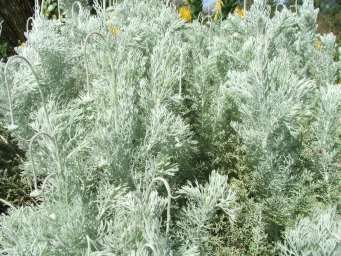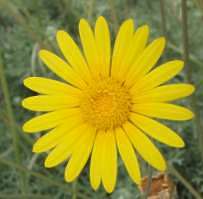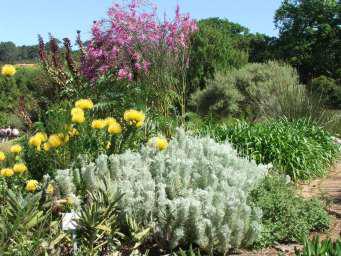Ursinia sericea
Ursinia sericea (Thunb.) N.E.Br.
Family: Asteraceae
Common names: silver lace-leaf ursinia (Eng.); geelmagriet (Afr.)
Introduction
Ursinia sericea is an attractive, easy-to-grow perennial, adding texture and silver highlights to the garden.

Description
Description
The lace-leaf ursinia is an herbaceous perennial which grows into a bushy shrublet, 200-500 mm high and wide. The silver, hairy leaves are toothed or finely divided; they are also once or twice pinnately lobed, which gives the plant its lacy, feathery appearance.

The bright golden yellow flower heads are solitary, on long, naked stalks, nodding while in bud. The flower head has a diameter of 20-50 mm. The involucral bracts, which are without appendages, are in several rows. Most of the inner row is usually covered by a conspicuous, papery tip. Margins of the involucral bracts are membranous. The seeds are usually topped with prominent, scale-like scales. Flowering is in spring to late summer (from September to February).

Conservation Status
Status
Ursinia sericea is not threatened and there is currently no decline in the population of this widespread species.
Distribution and habitat
Distribution description
With almost 40 species in southern Africa and even extending into North Africa, this genus shows lots of variation. It differs regarding growth forms, from annuals to perennial dwarf shrubs, and has myriad ecological preferences coupled with a wide geographical distribution.
Ursinia sericea occurs in the Fynbos and Succulent Karoo Biomes from Namaqualand to the Swartberg Mountains, where it grows on the upper sandstone slopes.

Derivation of name and historical aspects
History
The genus Ursinia was named by the German physician and botanist, Joseph Gaertner (1732-1791), after the author of Arboretum Bilicum, Johann Heinrich Ursinus of Regensburg (1608-1666). The species name sericea is derived from Latin and means silky.
Ecology
Ecology
The seeds are light in weight and have a tuft of papery scales at the tip, which aids wind dispersal.
Growing Ursinia sericea
Grow
Propagate this perennial from seeds sown during the autumn (March or April), or alternatively take cuttings during the warmer months. Use a well-drained medium, such as a mixture of bark and polystyrene, or river sand. Place in a mist unit where rooting will occur within 14 days. Plant in light, well-drained, compost-enriched soil. This is a plant for full sun, otherwise it will not thrive. Water well, but take care not to overwater.
Ursinia sericea is ideally suited to an informal border where its silvery grey foliage will lighten up the garden. It will add colour to a rockery, is an excellent accent plant at the base of a flight of steps, does well in window boxes, and is a versatile edging plant and groundcover. Not only does it grow well with plants such as Felicia amelloides, F. aethiopica (white and blue), F. filifolia, Lobelia valida and Pelargonium betulinum (white, pink and mauve), but it also makes a striking colour combination when in bloom.
References
- Eliovsen, S. 1960. South African wild flowers for the garden. How to grow them, identify them and use them for effect, edn 3. Howard Timmens, Cape Town.
- Goldblatt, P. & Manning, J. 2000. Wildflowers of the fairest Cape. Red Roof Design, Cape Town.
- Joffe, P. 1993. Gardener's guide to South African plants. Tafelberg, Cape Town.
- Trinder-Smith, T. 2003. Levyn's guide to the plant genera of the southwestern Cape. Red Roof Design, Cape Town.
- Van der Spuy, U. 1971. South African shrubs and trees for the garden. Hugh Keartland, Johannesburg.
- Van Rooyen, S. & Steyn, H. 1999. Cederberg: Clanwilliam and Biedouw Valley. South African Wild Flower Guide 10. Botanical Society of South Africa, Cape Town.
Credits
Roger Oliver
Kirstenbosch National Botanical Garden
November 2007
Plant Attributes:
Plant Type: Ground Cover, Perennial
SA Distribution: Northern Cape, Western Cape
Soil type: Sandy, Loam
Flowering season: Spring, Early Summer
PH: Acid
Flower colour: Yellow
Aspect: Full Sun
Gardening skill: Easy
Special Features:
Horticultural zones








Rate this article
Article well written and informative
Rate this plant
Is this an interesting plant?
Login to add your Comment
Back to topNot registered yet? Click here to register.